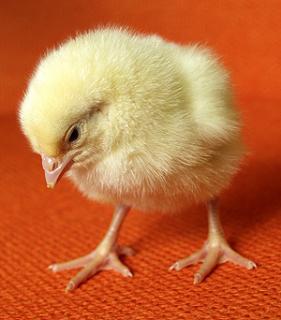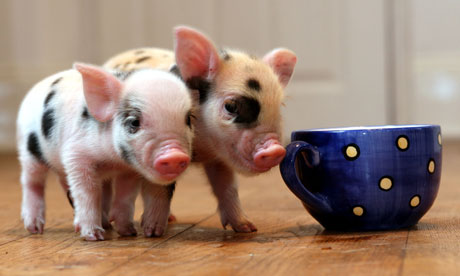Parents should think carefully about any pet, particularly small turtles, reptiles, and chicks or ducks, that can carry human disease. Young children are much more vulnerable to things like Salmonella.
And U.S. federal agencies continue to have a going public problem, and should develop public guidelines for when, or when not, to name a business or farm in a disease outbreak, and apply those guidelines consistently
That’s what I conclude from reports that health types have cracked an 8-year-old Salmonella outbreak linked to live, mail-order poultry.
JoNel Aleccia of msnbc.com writes, between 2004 and 2011, at least 316 people in 43 states were sickened by a strain of salmonella Montevideo that had stumped staff at the Centers for Disease Control and .jpg) Prevention. An estimated 5,000 additional cases likely went unreported, officials say.
Prevention. An estimated 5,000 additional cases likely went unreported, officials say.
Only through careful analysis of the genetic fingerprint of the bug and cooperation with human and animal health officials and poultry experts did the CDC crew link the cases to “Hatchery C,” a supplier of 4 million birds a year identified only as being in the western U.S.
“It was definitely an interesting outbreak,” said Casey Barton Behravesh, one of a team of CDC researchers who reported on their investigation in the latest issue of the New England Journal of Medicine.
Because the hatchery was cooperative and because the threat of this particular infection appears to be over — with only one case of the outbreak strain reported so far this year — CDC officials declined to name the source of live young poultry popular as Easter presents or with urban backyard chicken farmers.
Since 1990, there have been 35 outbreaks of salmonella tied to contact with shipments of live, young poultry. CDC officials are investigating two separate outbreaks now, strains of salmonella Altona and salmonella Johannesburg, which together have sickened nearly 100 people in 24 states.
It was the salmonella Montevideo outbreak, though, that sent CDC officials scrambling to find out the source of infections whose victims were mostly children under the age of 5.
?In the end, about 80 percent of the illnesses were traced back to Hatchery C, which can ship as many as 250,000 birds a week in the spring, the peak season, according to the report. Even after the hatchery took steps to curtail salmonella transmission, the infections dropped, but did not stop.
Even when state agriculture officials have forced hatcheries to get rid of their birds, clean up the sites and start over, salmonella outbreaks have erupted again.
“Shutting down the hatcheries is not necessarily the answer here,” Behravesh said.
There are some 20 hatcheries in the U.S. that ship an estimated 50 million live poultry by mail-order every year, generating between $50 million and $70 million a year, said CDC officials, citing unpublished data.
In 2011, the U.S. Postal Service shipped some 237,778 boxes or 1.7 million pounds of live poultry, spokeswoman Sue Brennan told msnbc.com.
Many of those birds go to agricultural feed stores, where they may be sold as Easter pets. Others are shipped directly to urban farmers, including many who have adopted the recent trend of raising backyard flocks of chickens.
In this outbreak, the number of illnesses peaked in May of 2006, forcing interventions at Hatchery C, the paper reported.
Those included beefing up biosecurity and rodent control, decontaminating feed, replacing and updating old equipment, changing airflow, improving testing and giving vaccines to adult birds.
Such steps may be recommended, but not required, by the National Poultry Improvement Plan, a program of the U.S. Department of Agriculture. All compliance is voluntary, Behravesh noted.
Still, even after that effort, the salmonella infections didn’t cease completely, Behravesh said.
The CDC researchers called for more targeted efforts to raise awareness about the danger of salmonella infections from live poultry. Only about 21 percent of patients interviewed said they knew that poultry could transmit salmonella and only 7 percent said they were warned about the risk at the time of purchase.
Part of the problem is that people regard the young poultry as pets, often buying chicks dyed neon colors as holiday favors.
New England Journal of Medicine, 366;22
Nicholas H. Gaffga, M.D., M.P.H., Casey Barton Behravesh, D.V.M., Dr.P.H., Paul J. Ettestad, D.V.M., Chad B. Smelser, M.D., Andrew R. Rhorer, M.S., Alicia B. Cronquist, R.N., M.P.H., Nicole A. Comstock, M.S.P.H., Sally A. Bidol, M.P.H., Nehal J. Patel, M.P.H., Peter Gerner-Smidt, M.D., D.Med.Sci., William E. Keene, Ph.D., M.P.H., Thomas M. Gomez, D.V.M., Brett A. Hopkins, D.V.M., Ph.D., Mark J. Sotir, Ph.D., M.P.H., and Frederick J. Angulo, D.V.M., Ph.D.
http://www.nejm.org/doi/pdf/10.1056/NEJMoa1111818
Abstract
Background
Outbreaks of human salmonella infections are increasingly associated with contact with live poultry, but effective control measures are elusive. In 2005, a cluster of human salmonella Montevideo infections with a rare pattern on pulsed-field gel electrophoresis (the outbreak strain) was identified by PulseNet, a national subtyping network.
Methods
In cooperation with public health and animal health agencies, we conducted multistate investigations involving patient interviews, trace-back investigations, and environmental testing at a mail-order hatchery linked to the outbreak in order to identify the source of infections and prevent additional illnesses. A case was defined as an infection with the outbreak strain between 2004 and 2011.
Results
From 2004 through 2011, we identified 316 cases in 43 states. The median age of the patient was 4 years. Interviews were completed with 156 patients (or their caretakers) (49%), and 36 of these patients (23%) were hospitalized. Among the 145 patients for whom information was available, 80 (55%) had bloody diarrhea. Information on contact with live young poultry was available for 159 patients, and 122 of these patients (77%) reported having such contact. A mail-order hatchery in the western United States was identified in 81% of the trace-back investigations, and the outbreak strain was isolated from samples collected at the hatchery. After intervention at the hatchery, the number of human infections declined, but transmission continued.
Conclusions
We identified a prolonged multistate outbreak of salmonellosis, predominantly affecting young children and associated with contact with live young poultry from a mail-order hatchery. Interventions performed at the hatchery reduced, but did not eliminate, associated human infections, demonstrating the difficulty of eliminating salmonella transmission from live poultry.
And, in a new and separate outbreak, CDC 93 additional people have been sickened. The complete CDC report is available at http://www.cdc.gov/salmonella/live-poultry-05-12/index.html. Highlights below.
A total of 93 persons infected with outbreak strains of Salmonella Infantis, Salmonella Newport, and Salmonella Lille have been reported from 23 states.
 18 ill persons have been hospitalized, and one death possibly related to this outbreak is under investigation.
18 ill persons have been hospitalized, and one death possibly related to this outbreak is under investigation.
37% of ill persons are children 10 years of age or younger.
Collaborative investigative efforts of local, state, and federal public health and agriculture officials linked this outbreak of human Salmonella infections to exposure to chicks and ducklings from a single mail-order hatchery in Ohio.
Findings of multiple traceback investigations of live chicks and ducklings from homes of ill persons have identified a single mail-order hatchery in Ohio as the source of these chicks and ducklings. This is the same mail-order hatchery that was associated with the 2011 outbreak of Salmonella Altona and Salmonella Johannesburg infections. In May 2012, veterinarians from the Ohio Department of Agriculture inspected the mail-order hatchery and made recommendations for improvement.
Mail-order hatcheries, agricultural feed stores, and others that sell or display chicks, ducklings, and other live poultry should provide health-related information to owners and potential purchasers of these birds prior to the point of purchase. This should include information about the risk of acquiring a Salmonella infection from contact with live poultry.
Mail-order hatcheries, agricultural feed stores, and others who sell or display chicks, ducklings and other live poultry should provide health-related information to owners and potential purchasers of these birds prior to the point of purchase. This should include information about the risk of acquiring a Salmonella infection from contact with live poultry.
 nine illnesses in cats, including one death, the FDA said.
nine illnesses in cats, including one death, the FDA said.

.jpg) Prevention. An estimated 5,000 additional cases likely went unreported, officials say.
Prevention. An estimated 5,000 additional cases likely went unreported, officials say. 18 ill persons have been hospitalized, and one death possibly related to this outbreak is under investigation.
18 ill persons have been hospitalized, and one death possibly related to this outbreak is under investigation..jpg) belong to genogroup GII. Thus far, to our knowledge, no HuNoVs have been detected in pets.
belong to genogroup GII. Thus far, to our knowledge, no HuNoVs have been detected in pets. hunt in the wild, has resulted in a surge in illegal sales of raw wild game online, Florida wildlife investigators say.
hunt in the wild, has resulted in a surge in illegal sales of raw wild game online, Florida wildlife investigators say. game hunted in-season. They threaten to create black markets for wildlife similar to what existed for alligators 50 years ago, Wilson said.
game hunted in-season. They threaten to create black markets for wildlife similar to what existed for alligators 50 years ago, Wilson said. set to warn this week that they risk spreading dangerous diseases.
set to warn this week that they risk spreading dangerous diseases.